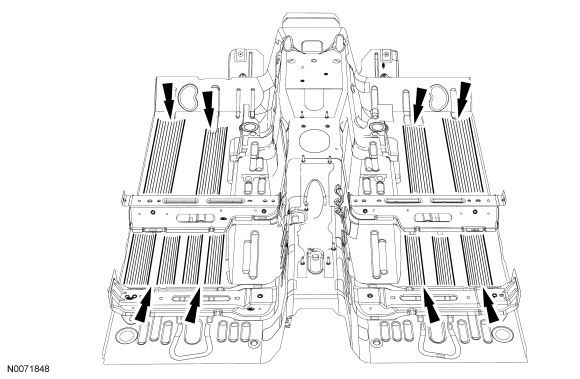SECTION 501-35: Body Repairs
| 2014 Mustang Workshop Manual
|
DESCRIPTION AND OPERATION
| Procedure revision date: 01/07/2013
|
Sound Deadeners and Insulators
 WARNING: Always refer to Material Safety Data Sheet (MSDS) when handling chemicals and wear protective equipment as directed. Examples may include but are not limited to respirators and chemically resistant gloves. Failure to follow these instructions may result in serious personal injury.
WARNING: Always refer to Material Safety Data Sheet (MSDS) when handling chemicals and wear protective equipment as directed. Examples may include but are not limited to respirators and chemically resistant gloves. Failure to follow these instructions may result in serious personal injury.
NOTICE:
Mastic is made of a combustible material and should be removed prior to carrying out welding procedures to the area. Heat zones from welding near the mastic can cause the mastic material to burn.
NOTICE:
Corrosion protection must be restored to the area AFTER the mastic material is applied. Corrosion protection products may be wax based and loss of adhesion may occur.
NOTE:
The following illustrations serve as a reference to indicate mastic patch (butyl pad) locations. Additional insulators and sound deadeners are used beyond those indicated in the illustration.
NOTE:
To restore the vehicle to design intent, missing or damaged sound deadeners and insulators should be replaced with the correct service replacement component. Illustration indicates pumpable mastic material applied as indicated.
Floor Pan

NOTE:
In applications where mastic material is applied as a pumpable material at the factory, replacement of missing or damaged mastic is acceptable in the form of cut-to-fit butyl pad(s) or pumpable mastic material(s) when carrying out repairs.
Whenever replacement of an existing mastic insulator is carried out, the surface must be thoroughly cleaned to make sure correct adhesion will occur. The surface should be 10°C (50°F) or greater before applying the mastic. The use of a heat gun to warm the metal surface will aid in adhesion.
 WARNING: Always refer to Material Safety Data Sheet (MSDS) when handling chemicals and wear protective equipment as directed. Examples may include but are not limited to respirators and chemically resistant gloves. Failure to follow these instructions may result in serious personal injury.
WARNING: Always refer to Material Safety Data Sheet (MSDS) when handling chemicals and wear protective equipment as directed. Examples may include but are not limited to respirators and chemically resistant gloves. Failure to follow these instructions may result in serious personal injury.
